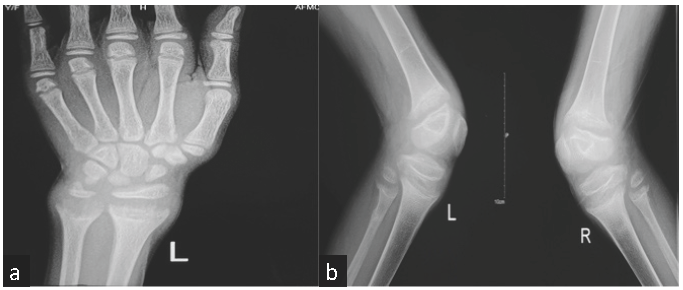Translate this page into:
A Rare Case of Autoimmune Thyroid Disease Associated Nephropathy in a Child
Corresponding author: Suchi Acharya, Department of Pediatrics, Armed Forces Medical College, Pune, India. E-mail: suchi.acharya@yahoo.co.in
-
Received: ,
Accepted: ,
How to cite this article: Acharya S, Roy S. A Rare Case of Autoimmune Thyroid Disease Associated Nephropathy in a Child. Indian J Nephrol. doi: 10.25259/IJN_130_2025
Dear Editor,
Autoimmune thyroid disease (AITD) is often accompanied by damage and lesions on several organs. AITD-associated nephropathy is rare.1,2 We report a 14-year-old developmentally normal girl who presented with short stature, bilateral genu valgus deformity, menstrual irregularities, and constipation for the last 3-4 years. Examination showed paleness, hypertension (BP=140/90 mmHg), proportionately short stature, bilateral wrist widening, genu valgus, and rachitic rosary [Figure 1]. Her investigations revealed microcytic hypochromic anemia, uremia (urea-90 mg/dL, creatinine-3.4 mg/dL), with 12.5 mL/min/1.73m2 eGFR, hypocalcemia (6.4 mg/dL), hyperphosphatemia (phosphates- 6.5 mg/dL), high ALP (740 IU/L), low vitamin D3 (6 ng/mL) and high parathormone level (724 pg/mL). Urine analysis showed granular cast and proteinuria. Ultrasound abdomen revealed a bilateral small kidney (6.5, 6.7 cm) and a normal renal doppler. Radiography wrist and knee revealed features of rickets [Figure 2]. Autoimmune profile (ANA, ANCA, C3, C4, IgA) and viral markers (Hepatitis B, Hepatitis C, HIV) were normal. Further evaluation showed high TSH (>100 mIU/L) and very high anti TPO antibodies (>1000.00 IU/mL). She was diagnosed with stage V chronic kidney disease (CKD) associated with autoimmune hypothyroidism. Kidneys were shrunken, so a biopsy could not be done. Although CKD etiology could not be confirmed, it could be related to autoimmune hypothyroidism, which can be complicated by immune complex-mediated chronic glomerulonephritis and subsequent CKD.1,2 Glomerular involvement is seen in 10-30% AITD cases.2 The most common renal diseases in AITD are membranous nephropathy, membranoproliferative glomerulonephritis, minimal change disease, IgA nephropathy, focal segmental glomerulosclerosis, and antineutrophil cytoplasmic autoantibody vasculitis.3,4 Glomerular deposition of immunocomplexes of thyroglobulin and autoantibodies, as well as impaired immune tolerance for megalin (a thyrotrophin-regulated glycoprotein expressed on thyroid cells), are the most probable mechanisms causing nephropathy.2

- (a) Chest photograph showing rachitic rosary at left costochondral junction (black arrows), (b) Bilateral lower limb photograph showing genu valgus deformity.

- (a) Wrist radiography showing features of rickets, (b) bilateral knee radiography showing features of rickets (cupping, splaying, and fraying).
Conflicts of interest
There are no conflicts of interest.
References
- Autoimmune thyroiditis and glomerulopathies. Front Endocrinol (Lausanne). 2017;8:119.
- [CrossRef] [PubMed] [PubMed Central] [Google Scholar]
- Relationship between autoimmune thyroid disease and nephropathy: A clinicopathological study. Medicine (Baltimore). 2021;100:e26273.
- [CrossRef] [PubMed] [PubMed Central] [Google Scholar]
- Autoimmune thyroiditis in childhood. J Clin Res Pediatr Endocrinol. 2013;5:45-9.
- [CrossRef] [PubMed] [PubMed Central] [Google Scholar]
- Membranous nephropathy associated with profound hypothyroidism. Clin Case Rep. 2019;8:120-2.
- [CrossRef] [PubMed] [PubMed Central] [Google Scholar]






